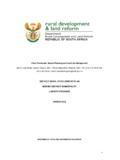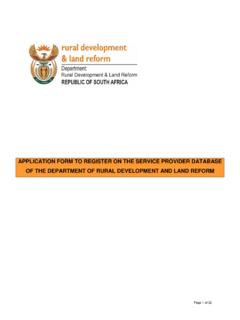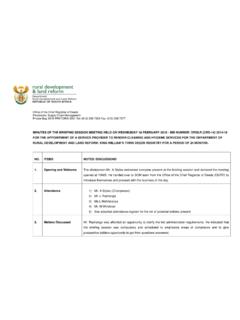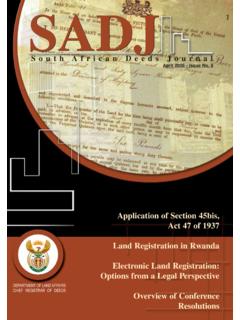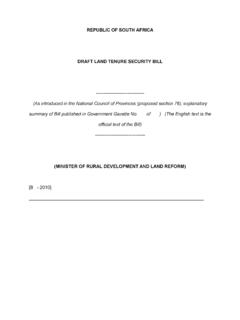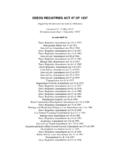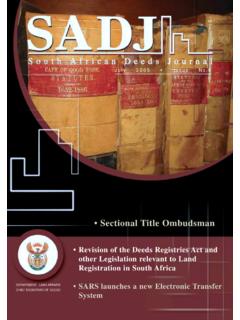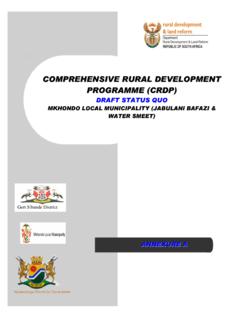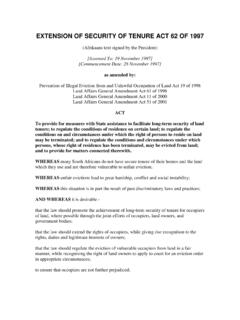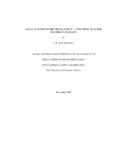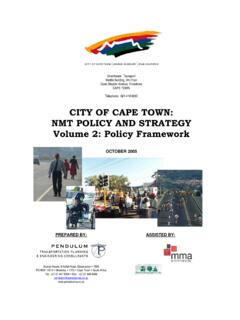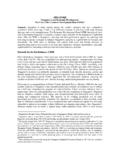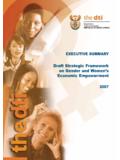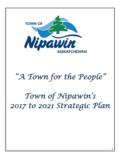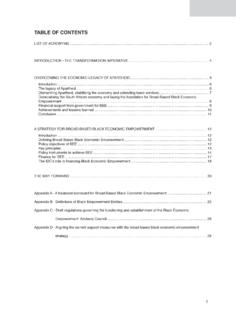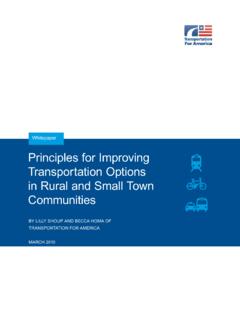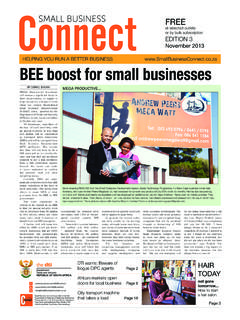Transcription of SIMPLIFIED SPATIAL DEVELOPMENT FRAMEWORK …
1 SIMPLIFIED SPATIAL DEVELOPMENT FRAMEWORK GUIDELINES 2011 SIMPLIFIED SPATIAL DEVELOPMENT Guidelines Department of Rural DEVELOPMENT and Land Reform: 2011 2 Statement of Intent In terms of Section 26(e) of the Local Government: Municipal Systems Act, No. 32 of 2000 (the MSA ) requires all municipalities to compile SPATIAL DEVELOPMENT Frameworks (the SDF ) as a core component of Integrated DEVELOPMENT Plans (the IDP ). The SDF Guidelines have been developed by the Department to ensure that the quality of SDFs is of high standard and to assist in directing and coordinating DEVELOPMENT within municipalities. The shortened version only contains some of the key aspects, therefore the shortened SDF Guideline must be read in consultation with the main SDF Guideline document as the main document captures comprehensive information and also contains relevant illustrations.
2 Contents INTRODUCTION TO THE SDF GUIDELINE ..7 i) ii) PURPOSE OF THE iii) INTENDED iv) CHARACTERISTICS OF THE INCREDIBLE v) THE PROCESS OF FORMULATING AN vi) vii) HOW TO ISE THE viii) FOCUS OF THE 1. PHASE 1: START-UP .. 9 CURRENT RELEVANT 9 GENERAL TIPS FOR PRODUCING AN SDF .. 9 FORMAT OF THE SDF DOCUMENT .. 10 LANGUAGE AND PITCH .. 10 RELATIONSHIP WITH IDP .. 10 TIMESPAN OF THE SDF .. 10 HIERARCHICAL DIFFERENTIATION OF THE SDF .. 10 2. PHASE 2: ISSUES AND VISION .. 11 PUBLIC PARTICIPATION .. 11 STAKEHOLDER IDENTIFICATION .. 11 GUIDELINES FOR ADVERTISING .. 12 OUTCOMES OF PHASE 2 .. 12 3. PHASE 3: SPATIAL ANALYSIS AND SYNTHESIS.
3 12 SPATIAL ANALYSIS .. 13 ANALYSIS MATRIX .. 13 SYNTHESIS OF THE PHASE 3 FINDINGS .. 14 OUTCOMES OF PHASE 3 .. 14 4. PHASE 4: DRAFT SDF .. 14 SPATIAL TOOLS AND CONCEPTS .. 15 SDF DOCUMENT .. 15 5. PHASE 5: ACHIEVING SUPPORT FOR DRAFT SDF .. 16 ABUTTING MUNICIPALITIES .. 16 OTHER GOVERNMENT DEPARTMENTS .. 16 KEY PRIVATE 16 TRADITIONAL LEADERS .. 16 POLITICAL SUPPORT .. 16 PUBLIC INPUT AND COMMENT ON THE DRAFT PROPOSALS .. 16 INPUTS FROM SECTOR EXPERTS .. 16 OUTCOMES OF PHASE 5 .. 17 6. PHASE 6: FINALISATION AND APPROVAL .. 17 ASSESSMENT OF INPUT RECEIVED .. 17 DECIDING ON AMENDMENTS .. 17 RECORD OF AMENDMENTS .. 17 ENDORSEMENT BY MUNICIPAL DEPARTMENTS AND OTHER GOVERNMENT AGENCIES.
4 17 LEGAL REQUIREMENTS FOR POLITICAL APPROVAL .. 17 Municipal approval in terms of section 25 of the Municipal Systems Act (Act 32 of 2000) .. 17 SIMPLIFIED SPATIAL DEVELOPMENT Guidelines Department of Rural DEVELOPMENT and Land Reform: 2011 3 Provincial approval .. 17 National DRDLR Notification .. 18 NOTIFICATION TO GENERAL 18 OUTCOMES OF PHASE 6 .. 18 7. PHASE 7: IMPLEMENTATION .. 18 IMPLEMENTATION .. 18 MONITORING .. 18 VISION CYCLES .. 18 20 year horizon .. 18 5 year SDF amendments .. 19 Annual revision .. 19 PRODUCTION AND REVIEW OF SECTOR PLANS AND ALIGNMENT WITH SDF 19 SDF REVIEW COMMITTEE .. 19 Glossary Communal Land Communal Land means land which is, or is to be, occupied or used by members of a community subject to the rules or custom of that community (Communal Land Rights Bill of 17 October 2003).
5 Community Community means a group of persons whose rights to land are derived from shared rules determining access to land held in common by such group (Communal Land Rights Bill of 17 October 2003). Corridors Corridors are links between nodes, along which an increased intensity of DEVELOPMENT may be encouraged. Corridors provide efficient access to a higher level of economic opportunities than would generally be the case in less structured space. They typically include public transport routes. Credible SPATIAL DEVELOPMENT FRAMEWORK (SDF) The definition credible includes the following meanings plausible, believable, apparently reasonable and valid.
6 It further means; capable of being conceived. A credible SDF is therefore one, which has adequately analysed the state of the municipality and details the drivers for change and effectively gives direction for the future growth and DEVELOPMENT of the municipality in alignment to government policies. It should also be equipped with a thorough implementation plan; comprising of costs, responsible persons, and lists of actionables from a short to long term period. Density Density is the number of units ( people, dwelling units, floor area) per unit of land area, dwelling units/ hectare. Densification Densification is the increased use of space both horizontally and vertically within existing areas/ properties and new developments, accompanied by an increased number of units and/or population threshold (CoCT, Draft SDF, 2009).
7 Efficiency DEVELOPMENT that maximises DEVELOPMENT goals such as sustainability, integration, accessibility, affordability, and quality of living, relative to financial, environmental, and social costs, including ongoing and future costs (Nelson Mandela Bay Municipality, 2007). Environmental Management FRAMEWORK An Environmental Management FRAMEWORK (EMF) provides a study of the biophysical and socio-cultural systems of a geographically defined area to reveal where specific land uses may best be practiced and to offer performance standards for maintaining appropriate use of such land (Cape Gateway, 2010) Food Security Physical and economic access, at all times, to sufficient, safe and nutritious food to meet dietary needs and food preferences for an active and healthy life.
8 (FAO, 2005) Hamlet A hamlet is a small village without a church. the people inhabiting hamlet do not lack faith, but it is due to lack of population and finance to support such a permanent home or afford a preacher or a teacher SIMPLIFIED SPATIAL DEVELOPMENT Guidelines Department of Rural DEVELOPMENT and Land Reform: 2011 4 Infill DEVELOPMENT DEVELOPMENT of vacant or underutilised land within existing settlements in order to optimise the use of infrastructure, increase urban densities and promote integration. Integrated DEVELOPMENT Plan The strategic municipal DEVELOPMENT plan, reviewed on an annual basis, required by the MSA (Act 32 of 2000) which guides municipal decisions and budgets as well as the DEVELOPMENT programs of SoEs and the private sector.
9 Land Use Management Establishing or implementing any measure to regulate the use or a change in the form or function of land, and includes land DEVELOPMENT (S1, Land Use Management Bill, 2008). Land Use Management System A system used to regulate land use in a municipality, including a town planning or zoning scheme, or policies related to how land is used on a plot by plot basis. Nodes Nodes are areas where a higher intensity of land uses and activities are supported and promoted. Typically any given municipal area would accommodate a hierarchy of nodes that indicates the relative intensity of DEVELOPMENT anticipated for the various nodes, their varying sizes, and their dominant nature.
10 Rural Areas and Rural DEVELOPMENT - can be defined as areas outside urban settlements where population densities are less than 150 people / km ; and - dwelling densities are less than 1du/ ha. Rural DEVELOPMENT generally includes primary economic activities; agriculture, agro-processing, mining, tourism, resource extraction, water, energy. Scenario A plausible and often SIMPLIFIED option of how the future may develop, based on a coherent and internally consistent set of assumptions about driving forces and key relationships (IPCC, 2007). Often a set of different scenarios are considered as part of the process of agreeing on a way forward.
